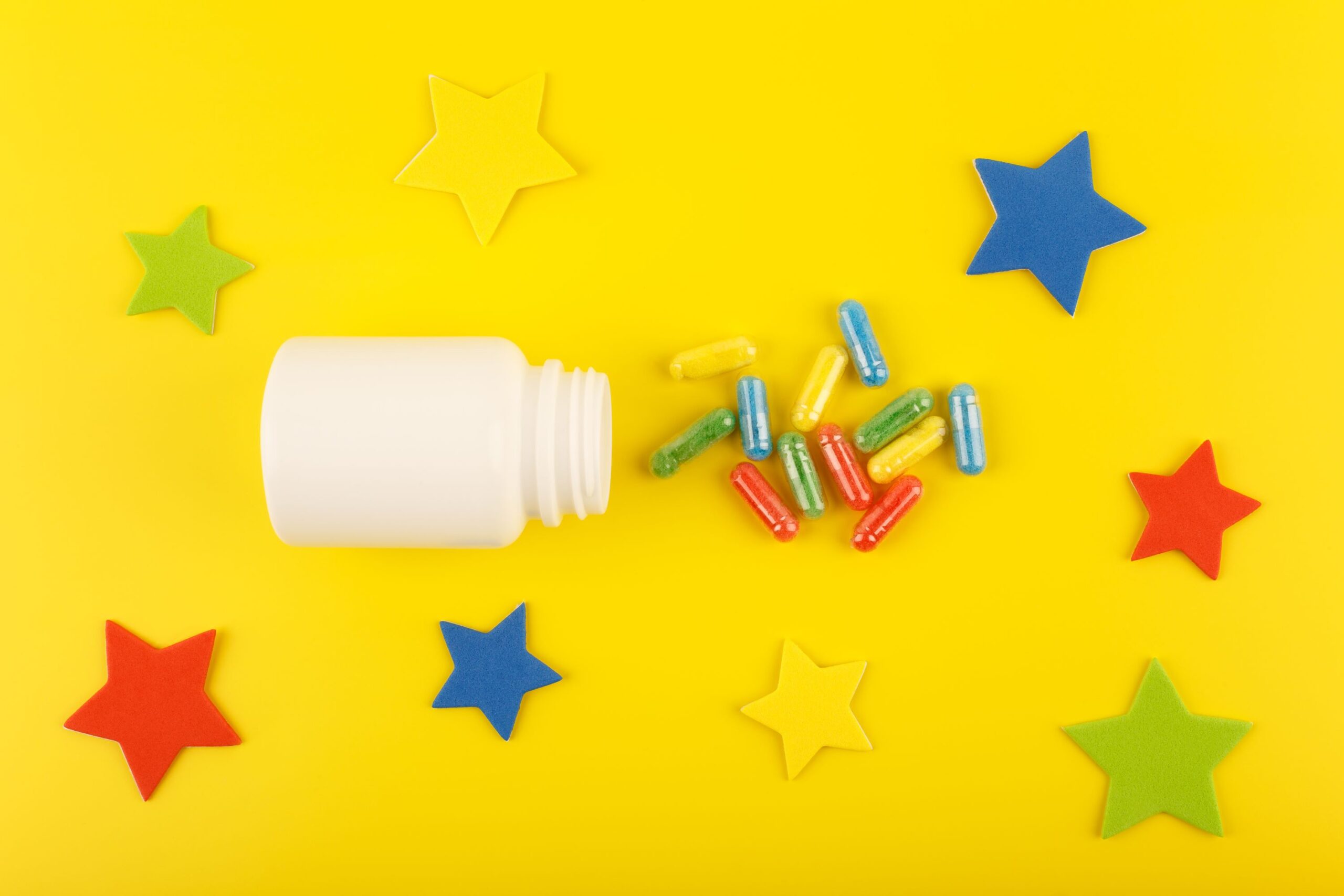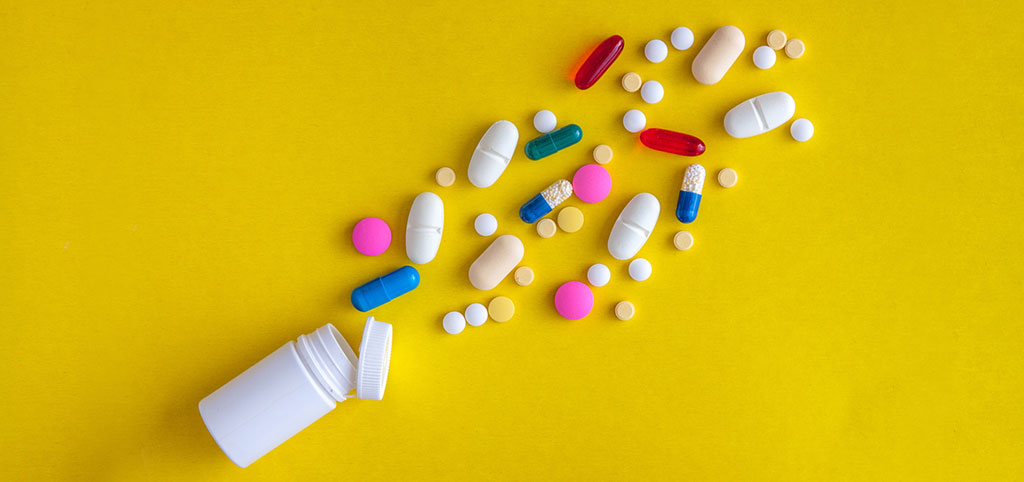If you’re a parent, a teacher, or a student, it probably comes as no surprise that heading back to school with crowds of kids in enclosed spaces also means a greater likelihood of exposure to upper respiratory tract infections, particularly the common cold. In fact, research[1] has shown a rapid rise of the common cold within two weeks of school opening. While it is outside of our control to avoid this type of exposure, one thing that is within our control is to help ensure that critical nutrients are provided to help act as immune system boosters for kids.
Examples of Immune-boosting Nutrients
What nutrients are good for children’s immune system? Several nutrients are critical, including immune-boosting vitamins such as vitamins C and D. Minerals like zinc and selenium also play crucial roles. In addition, probiotics can also provide excellent effects in supporting immune health.
Vitamins and Minerals
Vitamin C
Vitamin C is an effective antioxidant that helps support a healthy immune system, including the function of immune cells[2] [3] [4]. Furthermore, vitamin C may help improve the antioxidant activity of some white blood cells[5]. Common supplemental sources of vitamin C include ascorbic acid, mineral ascorbates (e.g., calcium ascorbate) and a fat-soluble source known as ascorbyl palmitate. In addition, there is a well-researched and highly bioavailable source of vitamin C know as Liposomal Pureway C.
The estimated global size of the vitamin C market was $1.95 billion in 2023, and industry experts project it will grow at a compounded annual growth rate (CAGR) of 4.3% through 2030[6].
Vitamin D
Vitamin D helps act as a modulator of the immune system, regulating immune response, and enhancing innate and adaptive immunity[7] [8] [9]. As a testament to its importance in immune health, the vitamin D receptor is expressed in immune cells (B cells, T cells, and antigen-presenting cells), and these immunologic cells are all capable of synthesizing the active vitamin D metabolite[10].
Vitamin D is available in D2 and D3 forms. Vitamin D3 (cholecalciferol) is widely recognized as being far more biologically active, and therefore the preferred form of vitamin D. Vitamin D3 can be derived from lanolin from sheep’s wool via a synthetic process, or extracted from plant lichen from which it is naturally occurring.
The global size of the vitamin D market was valued at $1.69 billion in 2023 and is projected to grow at a CAGR of 7.48% through 2032[11].
Zinc
Zinc is an essential mineral that supports immune function. It is essential for the integrity of the immune system, from the barrier of the skin to cellular function[12] [13] [14]. Zinc plays important roles in cell-mediated immunity, antibody reactions and antibody affinity, the complement system, and phagocyte activity[15].
There are many zinc salts, or forms of zinc, most of which have good absorption. These include zinc gluconate, zinc citrate and zinc picolinate—to name a few. If you’re using zinc in a liquid or powdered formula which the end user will taste, then it is best to use zinc citrate which has better taste parameters.
The global size of the zinc market was valued at $4.69 billion in 2022 and is projected to grow at a CAGR of 9.4% through 2030[16].
Selenium
Selenium is an antioxidant mineral that supports a healthy immune system, providing antioxidant protection against free radicals and other damaging reactive oxygen species[17] [18] [19].
Selenium is also needed to produce the antioxidant glutathione peroxidase, which protects neutrophils and vital immune system components[20]. Selenium is available in a few different forms, including sodium selenite and selenomethionine. The latter is generally considered to have better bioavailability.[21].
The global size of the selenium market was valued at $1.02 billion in 2022 and is projected to grow at a CAGR of 5.3% through 2032[22].
Probiotics
There is ample evidence suggesting that changes in the gut microbiota (balance of healthy bacteria in the gut) play an important role in promoting immunity. In particular, the microbiota of children is highly susceptible to environmental influences. Consequently, probiotics and their ability to promote and support a healthy microbiome have been extensively studied. The most well-researched probiotics are those species that fall into the Lactobacillus and Bifidobacteria genera.
Lactobacillus
Lactobacillus refers to a group of lactic acid-producing, friendly bacteria[23] [24] that make up many of the 400 normal probiotic species in the human body.[25] [26] [27] [28] [29] Two of the most common Lactobacilli include L. acidophilus and L. rhamnosus. Lactobacilli provide many benefits, including the following:
- Inducing growth factors and increasing the bioavailability of minerals.[30]
- Stabilizing the mucosal barrier and decreasing intestinal permeability.[31] [32]
- Reducing undesirable bacteria by producing lactic acid and hydrogen peroxide.[33] [34] [35]
- Immunomodulating effects[36] [37] [38] such as promoting healthy immune function.[39]
- Promoting healthy levels of Candida albicans.[40]
Bifidobacterium
Bifidobacteria normally colonize in the human colon [41] [42] and, like Lactobacillus species, also produce lactic acid. These probiotics are important organisms in the intestine in helping to create a microbial barrier to undesirable bacteria.[43] [44] In fact, some species of Bifidobacteria (including B. infantis, B. breve, and B. longum) bind to the intestinal mucosa and interfere with the attachment of undesirable bacteria.[45] [46]
Since Bifidobacteria disappear from the feces within 2 weeks after discontinuing supplementation, this suggests that there is no long-term colonization[47] [48] so Bifidobacteria must be used regularly to achieve a continued benefit.
In addition to capsules, other probiotic delivery forms include chews and powders. Individual serving options such as powders in a stick pack are good alternatives for children or people who prefer not to swallow capsules.
Currently, the value of the children’s probiotic market is approximately $1.77 billion and is expected to reach $2.75 billion by 2034[49].
Immunity-boosting habits
In addition to nutrients discussed in this article, there are other immunity-boosting habits that can help kids stay healthy. These include a healthy diet, hand hygiene, hydration, sleep, and exercise.
- Healthy Diet – A healthy diet plays a major role in promoting a healthy immune system in children. Research[50] has documented the importance of adequate protein in supporting innate and adaptive immune functions. Likewise, Harvard Health[51] has explained the importance of a healthy diet with lots of fruits and vegetables, whole grains, and lean protein, as well as dairy or another source of calcium, and healthy fats, like vegetable oils.
- Hand Hygiene – Handwashing is an easy, cheap, and effective way to prevent the spread of germs and keep kids healthy. Handwashing can become a lifelong healthy habit if you start teaching it at an early age. Teach kids the five easy steps for handwashing—wet, lather, scrub, rinse, and dry—and the key times to wash hands, such as after using the bathroom or before eating[52].
- Hydration – To stay well hydrated, the American Academy of Pediatrics (AAP) offers guidelines that children between ages 1 and 3 years of age drink 4 cups of beverages per day, including water and milk. Children 4 to 8 years of age should aim for 5 cups per day, and older children 7 to 8 cups per day[53].
- Getting Good Sleep – Children need adequate sleep to refresh and recharge their bodies. The amount of sleep a child requires varies by age (from 12 to 16 hours a day for infants to eight to 10 hours for teens) and from child to child (some just need more than others). You can encourage healthy sleep by limiting exposure to digital devices. Devices should be shut off an hour or two before bedtime and preferably not be in the bedroom at night and keeping to a regular schedule[54].
- Exercise – Ideally, children should be active for an hour per day. “Active” doesn’t have to mean playing a sport or going to the gym; it could be playing at the playground or going for a walk. More is not necessarily better; if you have a child who is a serious athlete, exercising several hours a day, make sure that the exercise isn’t eating into sleep or causing burnout, both of which could cause problems with the immune system[55].
FAQ:
Q: How big is the immune booster market?
The size of the Immune Health Supplements market was $19.3 billion in 2023. Industry experts project it will grow at a CAGR beyond 10.5% over the forecast period of 2023-2030[56].
Q: What are the trends for immune health in 2024?
Whether you’re reading blogs or walking the floor at dietary supplement industry trade shows, it is evident that probiotics are heavily trending in the immune health category. This also includes prebiotics and postbiotics[57].
Concluding Thoughts
If you’re considering expanding your product line to include immune support supplements—including immune system boosters for kids heading back to school in the fall —you’ll certainly want to include some well-established immune support nutrients in your product (such as those previously discussed).
You’ll also want to consider the inclusion of additional nutraceuticals to differentiate your product from others on the market. Of course, differentiation is an ongoing process. You’ll need to regularly reassess market trends, consumer needs, and industry advancements to refine and adapt your strategies, and of course, choosing the right contract supplement manufacturer can help.
Vitaquest, a trusted contract supplement manufacturer with over 45 years of experience, has an extensive background in manufacturing immune health supplements. With this experience, Vitaquest can provide guidance and technical expertise to help ensure that your immune health supplements exceed your expectations for quality, innovation, and reliability. In addition to manufacturing, we also provide convenient packaging design, best-in-class particle engineering services, and supplement fulfillment solutions.
To learn more about how we can help you Deliver What’s Next in the immune support supplements market, call 800-526-9095 to speak with one of our knowledgeable sales executives or request a competitive nutraceutical manufacturing price quote if you already have your project requirements prepared.
References:
[1] Perry Markovich M, Glatman-Freedman A, Bromberg M, et al. Back-to-school upper respiratory infection in preschool and primary school-age children in Israel. Pediatr Infect Dis J. 2015;34(5):476-481. doi:10.1097/INF.0000000000000627
[2] Food and Nutrition Board, Institute of Medicine. Vitamin C. Dietary Reference Intakes for Vitamin C, Vitamin E, Selenium, and Carotenoids. Washington D.C.: National Academy Press; 2000:117.
[3] Ströhle A, Wolters M, Hahn A. Micronutrients at the interface between inflammation and infection–ascorbic acid and calciferol: part 1, general overview with a focus on ascorbic acid. Inflamm Allergy Drug Targets. 2011 Feb;10(1):54-63.
[4] Sasazuki S, Sasaki S, Tsubono Y, Okubo S, Hayashi M, Tsugane S. Effect of vitamin C on common cold: randomized controlled trial. Eur J Clin Nutr. 2006 Jan;60(1):9-17.
[5] Khassaf M, McArdle A, Esanu C, Vasilaki A, McArdle F, Griffiths RD, Brodie DA, Jackson MJ. Effect of vitamin C supplements on antioxidant defence and stress proteins in human lymphocytes and skeletal muscle. J Physiol. 2003 Jun 1;549(Pt 2):645-52.
[6] U.S. Department of Agriculture, Agricultural Research Service, Beltsville Human Nutrition Research Center. FoodData Central. [Internet]. Accessed May 7, 2024 from https://fdc.nal.usda.gov/.
[7] Vitamin C Market Size & Trends. Grand View Research. Accessed May 7, 2024 from https://www.grandviewresearch.com/industry-analysis/vitamin-c-market-report.
[8] Lin R, White JH. The pleiotropic actions of vitamin D. Bioessays. 2004 Jan;26(1):21-8.
[9] Edfeldt K, Liu PT, Chun R, Fabri M, Schenk M, Wheelwright M, Keegan C, Krutzik SR, Adams JS, Hewison M, Modlin RL. T-cell cytokines differentially control human monocyte antimicrobial responses by regulating vitamin D metabolism. Proc Natl Acad Sci U S A. 2010 Dec 28;107(52):22593-8.
[10] Aranow C. Vitamin D and the immune system. J Investig Med. 2011 Aug;59(6):881-6.
[11] Aranow C. Vitamin D and the immune system. J Investig Med. 2011 Aug;59(6):881-6.
[12] U.S. Department of Agriculture, Agricultural Research Service, Beltsville Human Nutrition Research Center. FoodData Central. [Internet]. Accessed May 7, 2024 from https://fdc.nal.usda.gov/.
[13] Vitamin D Market. Straits Research. Accessed May 7, 2024 from https://straitsresearch.com/report/vitamin-d-market.
[14] Food and Nutrition Board, Institute of Medicine. Zinc. Dietary reference intakes for vitamin A, vitamin K, arsenic, boron, chromium, copper, iodine, iron, manganese, molybdenum, nickel, silicon, vanadium, and zinc. Washington, D.C.: National Academy Press; 2001:442-501.
[15] Prasad AS. Zinc in human health: effect of zinc on immune cells. Mol Med 2008; 14(5-6): 353-7.
[16] Shankar AH, Prasad AS. Zinc and immune function: the biological basis of altered resistance to infection. Am J Clin Nutr. 1998 Aug;68(2 Suppl):447S-463S.
[17] Kruse-Jarres JD. The significance of zinc for humoral and cellular immunity. J Trace Elem Electrolytes Health Dis. 1989 Mar;3(1):1-8.
[18] U.S. Department of Agriculture, Agricultural Research Service, Beltsville Human Nutrition Research Center. FoodData Central. [Internet]. Accessed May 7, 2024 from https://fdc.nal.usda.gov/.
[19] Global Zinc Supplement Market – Industry Trends and Forecast to 2030. Data Bridge Market Research. Accessed May 7, 2024 from https://www.databridgemarketresearch.com/reports/global-zinc-supplement-market.
[20] Food and Nutrition Board, Institute of Medicine. Selenium. Dietary reference intakes for vitamin C, vitamin E, selenium, and carotenoids. Washington D.C.: National Academy Press; 2000:284-324.
[21] Arthur JR, McKenzie RC, Beckett GJ. Selenium in the immune system. J Nutr 2003; 133(5 Suppl 1): 1457S-9S.
[22] Goldson AJ, Fairweather-Tait SJ, Armah CN, et al. Effects of selenium supplementation on selenoprotein gene expression and response to influenza vaccine challenge: a randomised controlled trial. PLoS One. 2011 Mar 21;6(3):e14771.
[23] Arthur JR, McKenzie RC, Beckett GJ. Selenium in the immune system. J Nutr 2003; 133(5 Suppl 1): 1457S-9S.
[24] U.S. Department of Agriculture, Agricultural Research Service, Beltsville Human Nutrition Research Center. FoodData Central. [Internet]. Accessed May 7, 2024 from https://fdc.nal.usda.gov/.
[25] Chelated Selenium Market Outlook. Future Market Insights. Accessed May 7, 2024 from https://www.futuremarketinsights.com/reports/chelated-selenium-market.
[26] Paytuví-Gallart A, Sanseverino W, Winger AM. Daily intake of probiotic strain Bacillus subtilis DE111 supports a healthy microbiome in children attending day-care. Benef Microbes. 2020 Nov 15;11(7):611-620.
[27] Probiotic for Kids Market Outlook. Future Market Insights. Accessed May 7, 2024 from https://www.futuremarketinsights.com/reports/probiotic-for-kids-market#:~:text=The%20probiotic%20market%20for%20kids,in%20kids%20with%20digestive%20disorders..
[28] Verduci E, Köglmeier J. Immunomodulation in Children: The Role of the Diet. J Pediatr Gastroenterol Nutr. 2021;73(3):293-298.
[29] McCarthy C. Boosting your child’s immune system. Harvard Health Publishing, Harvard Medical School. July 17, 2023. Accessed May 7, 2024 from https://www.health.harvard.edu/blog/boosting-your-childs-immune-system-202110122614.
[30] Handwashing: A Family Activity. Centers for Disease Control and Prevention. Accessed May 7, 2024 from https://www.cdc.gov/handwashing/handwashing-family.html#:~:text=Handwashing%20can%20become%20a%20lifelong,the%20bathroom%20or%20before%20eating.
[31] How to Keep Kids Hydrated. Children’s Hospital of Philadelphia. June 28, 2023. Accessed May 7, 2024 from https://www.chop.edu/news/health-tip/how-keep-kids-hydrated#:~:text=To%20stay%20well%20hydrated%2C%20the,to%208%20cups%20per%20day.
[32] McCarthy C. Boosting your child’s immune system. Harvard Health Publishing, Harvard Medical School. July 17, 2023. Accessed May 7, 2024 from https://www.health.harvard.edu/blog/boosting-your-childs-immune-system-202110122614.
[33] McCarthy C. Boosting your child’s immune system. Harvard Health Publishing, Harvard Medical School. July 17, 2023. Accessed May 7, 2024 from https://www.health.harvard.edu/blog/boosting-your-childs-immune-system-202110122614.
[34] Immune System Supplements Market to be Worth US$ 38.9 billion by 2030, Registering a Strong CAGR of 10.5% – Says a Market Report by RationalStat. Yahoo!Finance. Accessed May 7, 2024 from https://finance.yahoo.com/news/immune-system-supplements-market-worth-061200518.html.
[35] Masterson D. Immunity plus: The latest trend in dietary supplements. 12-Oct-2023. Accessed May 7, 2024 from https://www.nutraingredients-usa.com/Article/2023/10/12/Immunity-plus-The-latest-trend-in-dietary-supplements#.
[36] Casas IA, Dobrogosz WJ. Validation of the probiotic concept: Lactobacillus reuteri confers broad-spectrum protection against disease in humans and animals. Microbial Ecology in Health and Disease 2000;12:247-85.
[37] Fujisawa T, Benno Y, Yaeshima T, Mitsuoka T. Taxonomic study of the Lactobacillus acidophilus group, with recognition of Lactobacillus gallinarum sp. nov. and Lactobacillus johnsonii sp. nov. and synonymy of Lactobacillus acidophilus group A3 (Johnson et al. 1980) with the type strain of Lactobacillus amylovorus (Nakamura 1981). Int J Syst Bacteriol 1992;42:487-91.
[38] McGroarty JA. Probiotic use of lactobacilli in the human female urogenital tract. FEMS Immunol Med Microbiol 1993;6:251-64.
[39] Bruce AW, Reid G. Intravaginal instillation of Lactobacilli for prevention of recurrent urinary tract infections. Can J Microbiol 1988;34:339-43.
[40] Gupta K, Stapleton AE, Hooton TM, et al. Inverse association of H2O2-producing Lactobacilli and vaginal Escherichia coli colonization in women with recurrent urinary tract infections. J Infect Dis 1998;178:446-50.
[41] Madsen KL, Doyle JS, Jewell LD, et al. Lactobacillus species prevents colitis in interleukin 10 gene-deficient mice. Gastroenterology 1999;116:1107-14.
[42] Casas IA, Dobrogosz WJ. Validation of the probiotic concept: Lactobacillus reuteri confers broad-spectrum protection against disease in humans and animals. Microbial Ecology in Health and Disease 2000;12:247-85.
[43] Madsen KL, Doyle JS, Jewell LD, et al. Lactobacillus species prevents colitis in interleukin 10 gene-deficient mice. Gastroenterology 1999;116:1107-14.
[44] Shornikova AV, Casas IA, Isolauri E, et al. Lactobacillus reuteri as a therapeutic agent in acute diarrhea in young children. J Pediatr Gastroenterol Nutr 1997;24:399-404.
[45] Schultz M, Sartor RB. Probiotics and inflammatory bowel diseases. Am J Gastroenterol 2000;95:S19-21.
[46] deRoos NM, Katan MB. Effects of probiotic bacteria on diarrhea, lipid metabolism, and carcinogenesis: a review of papers published between 1988 and 1998. Am J Clin Nutr 2000;71:405-11.
[47] Isolauri E, Sutas Y, Kankaanpaa P et al. Probiotics: effects on immunity. Am J Clin Nutr 2001;73:444S-450S.
[48] Pelto L, Ioslauri E, Lilius EM, et al. Probiotic bacteria down-regulate the milk-induced inflammatory response in milk-hypersensitive subjects but have an immunostimulatory effect in healthy subjects. Clin Exp Allergy 1998;28:1474-9.
[49] Wagner RD, Pierson C, Warner T, et al. Biotherapeutic effects of probiotic bacteria on candidiasis in immunodeficient mice. Infect Immun 1997;65:4165-4172.
[50] Lievin V, Peiffer I, Hudault S, et al. Bifidobacterium strains from resident infant human gastrointestinal microflora exert antimicrobial activity. Gut 2000;47:646-52.
[51] Macfarlane GT, Cummings JH. Probiotics and prebiotics: can regulating the activities of intestinal bacteria benefit health? BMJ 1999;318:999-1003.
[52] Lievin V, Peiffer I, Hudault S, et al. Bifidobacterium strains from resident infant human gastrointestinal microflora exert antimicrobial activity. Gut 2000;47:646-52.
[53] Rastall RA. Bacteria in the gut: friends and foes and how to alter the balance. J Nutr 2004;134:2022S-2026S.
[54] Lievin V, Peiffer I, Hudault S, et al. Bifidobacterium strains from resident infant human gastrointestinal microflora exert antimicrobial activity. Gut 2000;47:646-52.
[55] Chen RM, Wu JJ, Lee SC, et al. Increase of intestinal Bifidobacterium and suppression of coliform bacteria with short-term yogurt ingestion. J Dairy Sci 1999:82:2308-14.
[66] Chiang BL, Sheih YH, Wang LH, et al. Enhancing immunity by dietary consumption of a probiotic lactic acid bacterium (Bifidobacterium lactis HN019): optimization and definition of cellular immune responses. Eur J Clin Nutr 2000;54:849-55.
[57] Lewis SJ, Freedman AR. Review article: the use of biotherapeutic agents in the prevention and treatment of gastrointestinal disease. Aliment Pharmacol Ther 1998;12:807-22.








